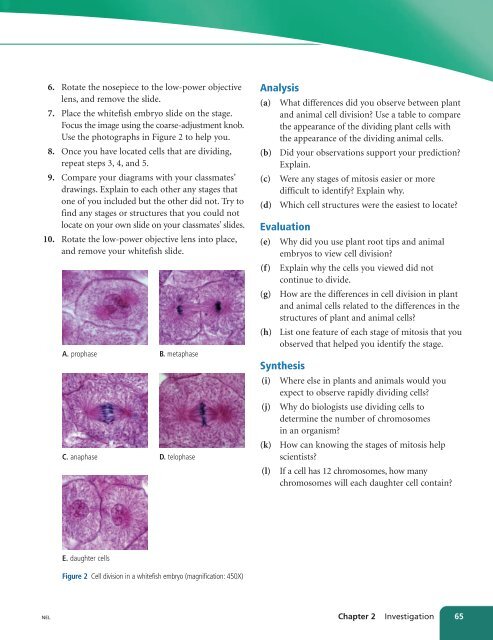Unit A Reproduction
Unit A Reproduction
Unit A Reproduction
You also want an ePaper? Increase the reach of your titles
YUMPU automatically turns print PDFs into web optimized ePapers that Google loves.
6. Rotate the nosepiece to the low-power objective<br />
lens, and remove the slide.<br />
7. Place the whitefish embryo slide on the stage.<br />
Focus the image using the coarse-adjustment knob.<br />
Use the photographs in Figure 2 to help you.<br />
8. Once you have located cells that are dividing,<br />
repeat steps 3, 4, and 5.<br />
9. Compare your diagrams with your classmates’<br />
drawings. Explain to each other any stages that<br />
one of you included but the other did not. Try to<br />
find any stages or structures that you could not<br />
locate on your own slide on your classmates’ slides.<br />
10. Rotate the low-power objective lens into place,<br />
and remove your whitefish slide.<br />
A. prophase B. metaphase<br />
C. anaphase D. telophase<br />
Analysis<br />
(a) What differences did you observe between plant<br />
and animal cell division? Use a table to compare<br />
the appearance of the dividing plant cells with<br />
the appearance of the dividing animal cells.<br />
(b) Did your observations support your prediction?<br />
Explain.<br />
(c) Were any stages of mitosis easier or more<br />
difficult to identify? Explain why.<br />
(d) Which cell structures were the easiest to locate?<br />
Evaluation<br />
(e)<br />
(f)<br />
(g)<br />
(h)<br />
Why did you use plant root tips and animal<br />
embryos to view cell division?<br />
Explain why the cells you viewed did not<br />
continue to divide.<br />
How are the differences in cell division in plant<br />
and animal cells related to the differences in the<br />
structures of plant and animal cells?<br />
List one feature of each stage of mitosis that you<br />
observed that helped you identify the stage.<br />
Synthesis<br />
(i) Where else in plants and animals would you<br />
expect to observe rapidly dividing cells?<br />
(j) Why do biologists use dividing cells to<br />
determine the number of chromosomes<br />
in an organism?<br />
(k) How can knowing the stages of mitosis help<br />
scientists?<br />
(l) If a cell has 12 chromosomes, how many<br />
chromosomes will each daughter cell contain?<br />
E. daughter cells<br />
Figure 2 Cell division in a whitefish embryo (magnification: 450X)<br />
NEL<br />
Chapter 2 Investigation 65

















